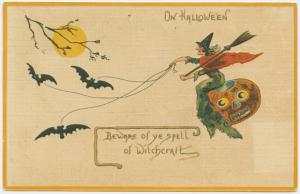The original Santa, or Saint Nicholas, was green and not red, as we portray him today. Not only that, but he had a totally different meaning to the Santa Claus we know today.
Santa Claus, also known as Saint Nicholas, Father Christmas and simply "Santa", is a figure with legendary, mythical, historical and folkloric origins who, in many western cultures, is said to bring gifts to the homes of the good children during the late evening and overnight hours of Christmas Eve, December 24. The modern figure was derived from the Dutch figure of Sinterklaas...
from Santa Claus page @ Wikipedia
The Santa we see in modern times only came about in the early 1950's, when Coca Cola had a problem with sales in some European countries. They adopted his image at the time for a couple of reasons: The first being Post war depression. But the main reason was Coca Cola was little known to Europeans, and the depression's effects made it harder.

Vintage Cocoa Cola Christmas Advert
One astute salesman (sent to Europe to help sales) -who happened to be studying children's stories- came across the legend of Saint Nicholas. (A character who willingly gave to children - to spread joy into their povity-stricken-lives.)
Deciding to use this fabled character in a world-wide marketing campaign, Coca Cola came up with a sales pitch to capture the market. They increased the sales of cola with a jolly fat man in a red and white suit, which perfectly matched their product colours, and instilled a feeling of joy (about a man like St. Nicholas who gave presents one day of each year to enrich their lives) even just for a while.
The Europeans ate up this American link to their own heritage seeing similarities to their own versions of St. Nicholas; especially as they didn't knowing this was created just to sell a product.

Spirit of Yule
It might be of surprise to realise that Santa's suit was originally green before Cocoa Cola changed it to their logo colours of red and white; and all just to push cola into the depressed European market. So strange, but really true.

The VuDooMan is in the House
When you need a little faith, turn to the VuDooMan
















